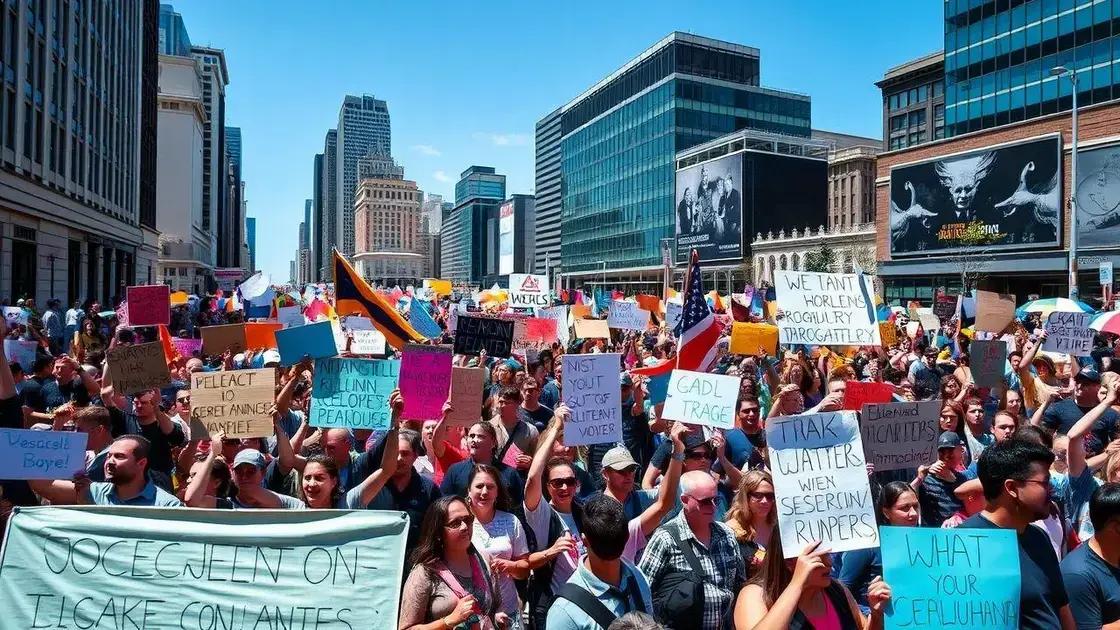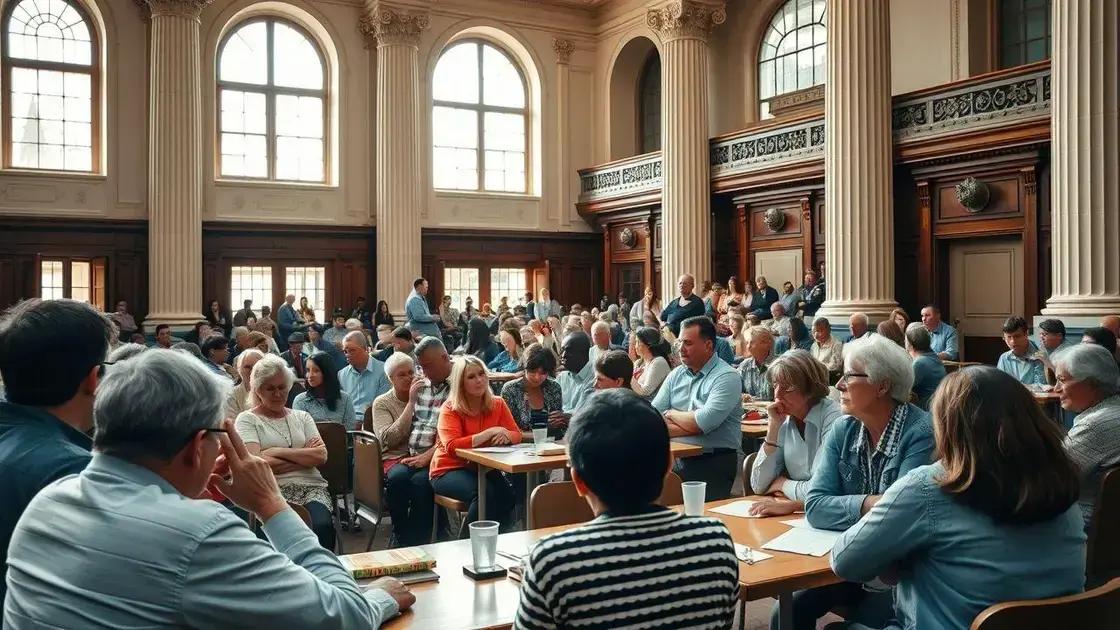Protesters rally in opposition to Trump-era regulations

Protesters rally in opposition to Trump-era regulations, raising concerns about environmental impacts, healthcare access, and social justice issues, while advocating for reforms that prioritize community needs and promote sustainability.
Protesters rally in opposition to Trump-era regulations shows the growing discontent among citizens affected by these policies. It’s fascinating to see how these demonstrations shape public discourse and influence future legislation. What are the key issues at stake, and how can we engage with them?
Understanding the Trump-era regulations
Understanding the Trump-era regulations is crucial for grasping the current political climate in the United States. These regulations have had a significant impact on various aspects, shaping policies that affect millions.
Key Features of Trump-era Regulations
During his administration, several key regulations were established. It’s important to examine what these regulations entail and who they affect. From environmental policies to financial regulations, the implications are widespread.
- Environmental Policy Changes: Many regulations were rolled back, impacting climate change efforts.
- Healthcare Regulations: Modifications to existing healthcare laws changed access and coverage for many.
- Financial Practices: New rules were introduced, altering how financial institutions operate.
Each of these areas shows how the Trump-era regulations aimed to shape a specific vision for the country. With changes affecting everything from the air we breathe to our health care, understanding these regulations is essential. Advocacy groups have been vocal about their concerns, highlighting the potential risks associated with these changes.
Public Response and Reactions
The public’s response to these regulations has been diverse. Many have rallied in opposition, pointing out how these regulations harm rather than help. Protests have taken place across the country, emphasizing community voices in this conversation.
Engagement from the community is vital, as people want their concerns addressed. Demonstrators often focus on specific issues, like climate change or healthcare, demanding reforms and new legislation. As debates continue, the importance of understanding what these regulations mean cannot be overstated.
Key issues driving protesters’ concerns
Key issues driving protesters’ concerns revolve around several critical areas that impact daily lives. Many individuals feel directly affected by recent changes, prompting them to voice their opinions publicly.
Impact on the Environment
One significant concern is the environmental policy changes implemented during the Trump administration. Many protesters argue that these changes threaten vital ecosystems and contribute to climate change. Citizens are rallying for stronger regulations to protect natural resources.
- Climate Change Acceleration: Reduced regulations often lead to higher emissions.
- Resource Exploitation: Deregulation can result in the overuse of natural resources.
- Community Health: Environmental degradation impacts public health.
Another critical issue is healthcare accessibility. Changes in how healthcare is delivered and funded have left many feeling vulnerable. With rising costs and limited access to care, communities are demanding better healthcare solutions.
Social Justice and Equality
Social justice concerns also play a significant role in mobilizing protesters. Many express frustration over perceived inequalities exacerbated by new regulations. People are advocating for policies that promote equity and justice for all.
- Economic Disparities: Many feel that deregulation favors the wealthy.
- Labor Rights: Workers’ rights have faced threats due to new policies.
- Community Representation: Calls for diverse voices in decision-making.
As the dialogue around these issues continues, protesters aim to raise awareness and push for change. Understanding what drives these concerns helps clarify the motivations behind the rallies we see today. Citizens are actively seeking reforms that align with their values and needs.
Impact on local communities and economies

The impact on local communities and economies due to recent regulations has become a critical concern for many. Communities are experiencing changes that affect their livelihoods and way of life.
Economic Consequences
Regulations can significantly affect local economies. For instance, new business regulations may discourage investment. This can lead to job losses and reduced economic activity.
- Job Losses: Businesses may close or downsize due to strict regulations.
- Decreased Investment: Investors might shy away from areas with heavy regulations.
- Higher Costs: Costs of compliance can raise the prices of goods and services.
Many local businesses find it challenging to adapt to these changes. As a result, communities may suffer from economic downturns that ripple through various sectors. This creates a cycle of challenges that can be hard to break.
Social Impacts
The social fabric of communities is also affected. As jobs become scarce, people struggle to make ends meet. This creates frustration and can lead to an increase in social unrest.
- Poverty Increase: Rising unemployment rates may lead to more families living in poverty.
- Community Division: Economic stress can create divides among community members.
- Decline in Public Services: Less revenue can result in reduced funding for essential services.
These challenges create a pressing need for dialogue and action. Communities are calling for solutions that not only support economic growth but also address the social issues arising from these regulations. The effects of policies ripple through local economies, intertwining economic health and social well-being.
Voices from the protesters
Voices from the protesters reflect a rich tapestry of concerns and hopes. Each participant brings a unique perspective that adds depth to the movement against recent regulations.
Personal Stories
Personal narratives are powerful tools for understanding the impact of policies. Protesters often share stories about how regulations have affected their lives. For instance, some emphasize the struggles faced by small business owners.
- Struggling Entrepreneurs: Many small business owners feel stifled by increased regulations that limit their ability to grow.
- Families in Crisis: Individuals discuss how changes to healthcare laws have threatened their access to essential services.
- Environmental Advocates: Activists highlight the urgency of protecting natural resources for future generations.
These stories resonate deeply with fellow protesters and help to create a sense of community. By sharing their experiences, individuals can unite others around common goals.
The Power of Community
The power of community shines through in protests. People gather from different backgrounds to express shared frustrations. Many believe that collective action is necessary to initiate change.
- Unity in Diversity: Protesters come together, regardless of their backgrounds, to fight for their rights.
- Support Networks: Communities build support systems, helping individuals navigate challenges posed by regulations.
- Empowerment: Joining together fosters a sense of empowerment among participants, inspiring them to advocate for change actively.
The voices of protesters serve as a crucial reminder that everyone has a role in shaping policies that affect their lives. Listening to these stories not only amplifies their concerns but also inspires action.
What’s next for regulatory reform?
What’s next for regulatory reform is a question on many minds. As protests continue, many advocates are pushing for changes that reflect community needs and values.
Potential Changes on the Horizon
The landscape of regulation is fluid, and future reforms may take several forms. There is a strong push for regulations that prioritize both economic growth and social welfare. Policymakers are facing pressure to consider the voices of those affected by these regulations.
- Listening to Stakeholders: Engaging communities in the regulatory process will be crucial.
- Balancing Interests: Finding a middle ground between business needs and public safety is vital.
- Innovative Solutions: Policymakers may explore creative approaches to regulation that include technological advancements.
As discussions unfold, new proposals and policies will arise. Advocates are eager to see regulations that not only protect the environment but also support local economies. Community members are raising their voices to ensure their concerns are heard.
Advocacy and Activism
The role of advocacy in regulatory reform cannot be overstated. Organizations and grassroots movements are crucial in shaping dialogue around these issues. Their efforts can push lawmakers to reconsider existing regulations and adopt more inclusive practices.
- Mobilizing Support: Activists are organizing to educate communities on regulatory issues.
- Building Coalitions: Partnerships among various groups can strengthen the call for reform.
- Engaging Politicians: Direct engagement with lawmakers can lead to greater alignment on important issues.
Regulatory reform is not just about changing laws; it’s about reshaping the relationship between the government and the people. The future will likely depend on how effectively community voices can influence decision-making processes. The path forward will also involve assessing the outcomes of current regulations to ensure they align with public interest.
The discussion around regulatory reform is ongoing and essential. As communities unite to express their concerns and demands, it’s clear that their voices matter. The future of regulations should reflect the needs of the people and the environment. By engaging in dialogue and advocacy, citizens can help shape policies that promote fairness and sustainability. Together, they can push for changes that lead to positive outcomes for everyone. The road ahead will involve collaboration, listening, and a commitment to creating a better world.
FAQ – Frequently Asked Questions about Regulatory Reform
What are the main concerns of protesters regarding regulations?
Protesters are mainly concerned about the impact of regulations on the environment, healthcare access, and social justice.
How can community voices influence regulatory changes?
Community voices can influence regulatory changes by mobilizing public support, engaging policymakers, and highlighting the effects of regulations on daily lives.
What role does advocacy play in shaping regulations?
Advocacy plays a crucial role by raising awareness, fostering dialogue, and pushing for reforms that reflect community needs.
Why is collaboration important for regulatory reform?
Collaboration brings together diverse perspectives, helping to create balanced policies that consider both economic growth and public welfare.






